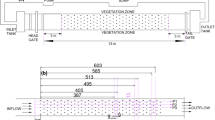Abstract
Traditionally, the overall diluting capacity of an estuary is characterized using a coefficient of longitudinal dispersion, K xe , which is given by the ratio of the dispersive flux of a dissolved substance to its tidally averaged longitudinal gradient. A steady-state model, which assumes a balance between the dispersive and non-dispersive fluxes and an exponential increase in estuary cross-sectional area towards the sea, has been used to derive expressions for the axial salinity distribution and the dispersive flux of salt. The model was set up assuming either a constant dispersion coefficient along the estuary or one that increased with distance towards the sea. By comparing salinity predictions with data from five UK estuaries, estimates were made of the maximum dispersive salt flux and the corresponding maximum salinity gradient for each system. The results indicated that there was an approximately linear relation between the fluxes and gradients, and the slope of a line plotted through the origin provided an estimate of a common K xe for all five estuaries. The magnitude of K xe was found to be about 90 m2 s−1 with a standard deviation of approximately ±32 m2 s−1. It is concluded that a representative value of 100 m2 s−1 for K xe is a reasonable first choice when setting up a cross-sectionally averaged estuary model. The results also showed that larger systems, such as the Thames, had lower salinity gradients and lower dispersive salt fluxes, whilst smaller estuaries displayed the opposite characteristics. The model was used to predict the variation in the non-advective flux of salt along an estuary. The distribution was found to be similar to the corresponding flux distribution estimated from observations at the seaward end of the Tees estuary, despite appreciable spatial variations in the individual flux components. Allowing for a small decrease in freshwater flow, the model indicated that there was a decrease in the maximum dispersive flux between neap and spring tides. It is argued that such a reduction in flux can result in a seaward shift in the salinity distribution to a region of greater cross-section, where the freshwater transport per unit area again balances the reduced upstream dispersive flux, as found in the neap to spring response in the Tees estuary.
Similar content being viewed by others
Acknowledgments.
The authors wish to express their thanks to Mr A.M. Riddle, Brixham Environmental Laboratory, AstraZeneca UK Ltd. for helpful comments on the manuscript.
Author information
Authors and Affiliations
Corresponding author
Additional information
Responsible Editor: Hans Burchard
Rights and permissions
About this article
Cite this article
Lewis, R., Uncles, R. Factors affecting longitudinal dispersion in estuaries of different scale. Ocean Dynamics 53, 197–207 (2003). https://doi.org/10.1007/s10236-003-0030-2
Received:
Accepted:
Issue Date:
DOI: https://doi.org/10.1007/s10236-003-0030-2




